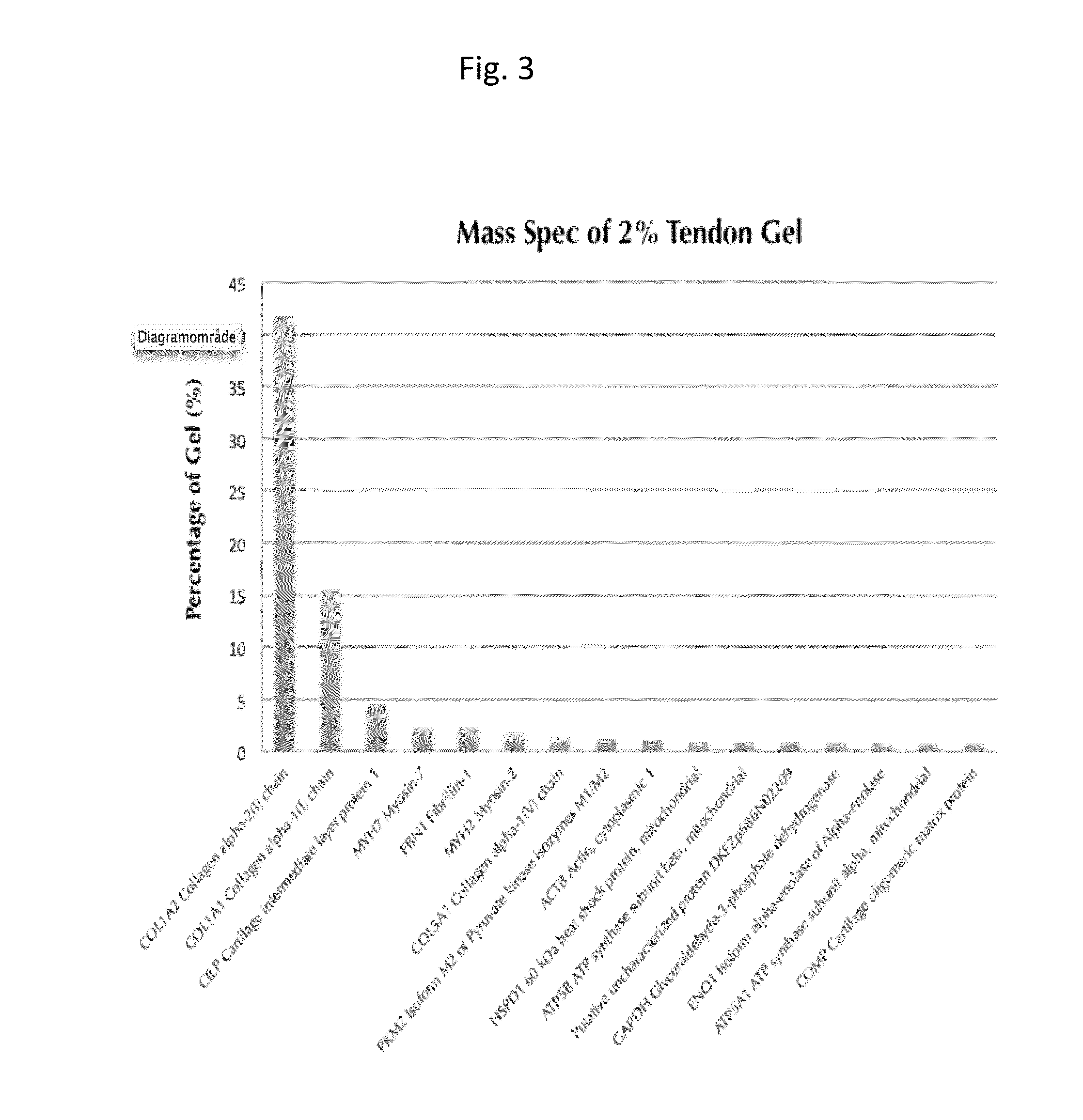Injectable composition for in-situ repair and regeneration of an injured ligament or tendon and methods of use
a technology of applied in the field of ligament and tendon injury treatment, can solve the problems of limiting the mobility of a joint, preventing certain movements, and accumulating microscopic tears, and achieve the effect of facilitating in-situ repair and regeneration of injured ligaments or tendon
- Summary
- Abstract
- Description
- Claims
- Application Information
AI Technical Summary
Benefits of technology
Problems solved by technology
Method used
Image
Examples
example 1
Injectable Human Tendon-Derived Hydrogel as a Scaffold for In-Situ Guided Tissue Regeneration in the Musculoskeletal System
1.1 Experimental Procedures
[0119]Tissue Decellularization and Material Processing.
[0120]Human flexor digitorum profundus (FDP), flexor digitorum superficialis (FDS) and flexor pollicis longus (FPL) tendons were harvested from fresh-frozen human cadaveric forearms (Science Care, Phoenix, Ariz.). Epitenon, synovial sheath, and muscle tissue were meticulously debrided. Distally, FDS tendons were transected 2 cm proximal to the chiasma, and FDP and FPL tendons were transected 1 cm proximal to the osteotendinous junction. The tendons were then decellularized following a previously reported protocol (Pridgen B C et al., 2011). In brief, scaffolds were treated with 0.1% ethylenediamine-tetraacetic acid (EDTA) for 4 hours followed by 0.1% sodium dodecyl sulfate (SDS) in 0.1% EDTA for 24 hours at room temperature with constant agitation. Scaffolds were washed in PBS (als...
example 2
Injectable Porcine Tendon Hydrogel as a Scaffold for In-Situ Guided Tissue Regeneration in the Musculoskeletal System
2.1 Experimental Procedures
[0157]Tissue Decellularization and Material Processing for the Manufacture of Human Tendon Hydrogel.
[0158]Flexor tendons were harvested from fresh cadaveric forearms, as described in example 1. These tendons were meticulously debrided of remaining synovial material and muscle tissue. Flexor digitorum superficialis tendons were transected 2 cm proximal to the chiasma, while flexor digitorum profundus and flexor pollicis longus tendons were transected 1 cm proximal to the osteotendinous insertion. Harvested tendons were subsequently cut into 1 cm segments and treated with 0.1% ethylenediaminetetraacetic acid (EDTA) for 4 hours and then washed in 0.1% sodium dodecyl sulfate (SDS) in 0.1% EDTA for 24 hours at ambient temperature with constant agitation. Tendon was then rinsed in 1×PBS for 4 hours and stored at −80° C.
[0159]Tissue Decellularizati...
example 3
Injectable Tendon Hydrogel Augments Tendon Healing in an Rat Achilles Tendon Injury Model
3.1 Experimental Procedures
[0199]Tissue Decellularization and Material Processing to Obtain Decellularized and Lyophilized Extracellular Matrix Material for the Subsequent Preparation of a Tendon (Hydro)Gel.
[0200]Human flexor digitorum profundus (FDP), flexor digitorum superficialis (FDS) and flexor pollicis longus (FPL) tendons were harvested from fresh-frozen human cadaveric forearms and processed as described in Example 1.
[0201]Extracellular ECM Gel Formation.
[0202]The extracellular matrix material was enzymatically digested by adding a 1 mg / ml solution of pepsin (Sigma, St Louis, Mo.) in 0.02 M HCl and sterile water such that the final concentration of material was 20 mg / ml, and pH was 2.2. The material was digested for 24 hours at room temperature with constant stirring. While the resulting liquid cooled on ice, the pH was first raised to 8 using NaOH to deactivate the pepsin, then lowered ...
PUM
| Property | Measurement | Unit |
|---|---|---|
| Composition | aaaaa | aaaaa |
| Therapeutic | aaaaa | aaaaa |
Abstract
Description
Claims
Application Information
 Login to View More
Login to View More - R&D Engineer
- R&D Manager
- IP Professional
- Industry Leading Data Capabilities
- Powerful AI technology
- Patent DNA Extraction
Browse by: Latest US Patents, China's latest patents, Technical Efficacy Thesaurus, Application Domain, Technology Topic, Popular Technical Reports.
© 2024 PatSnap. All rights reserved.Legal|Privacy policy|Modern Slavery Act Transparency Statement|Sitemap|About US| Contact US: help@patsnap.com










